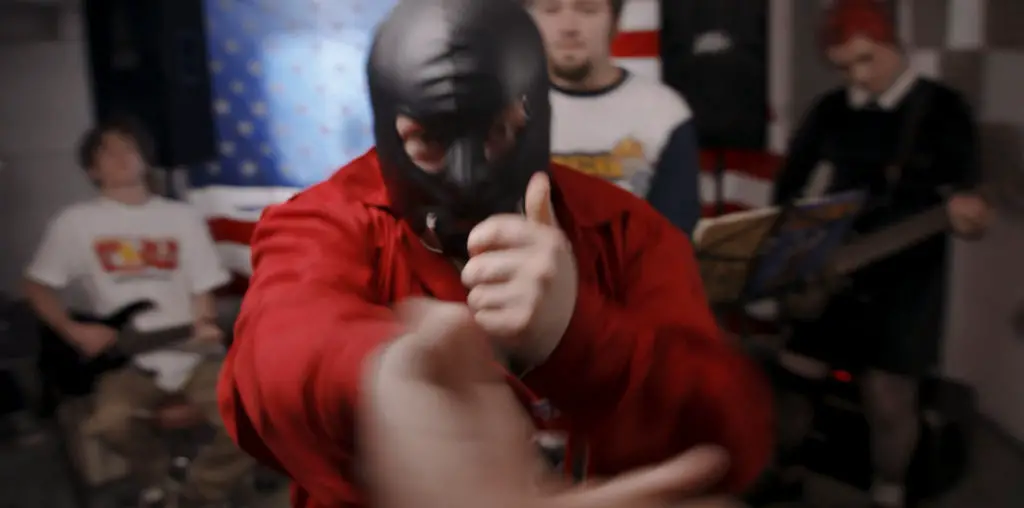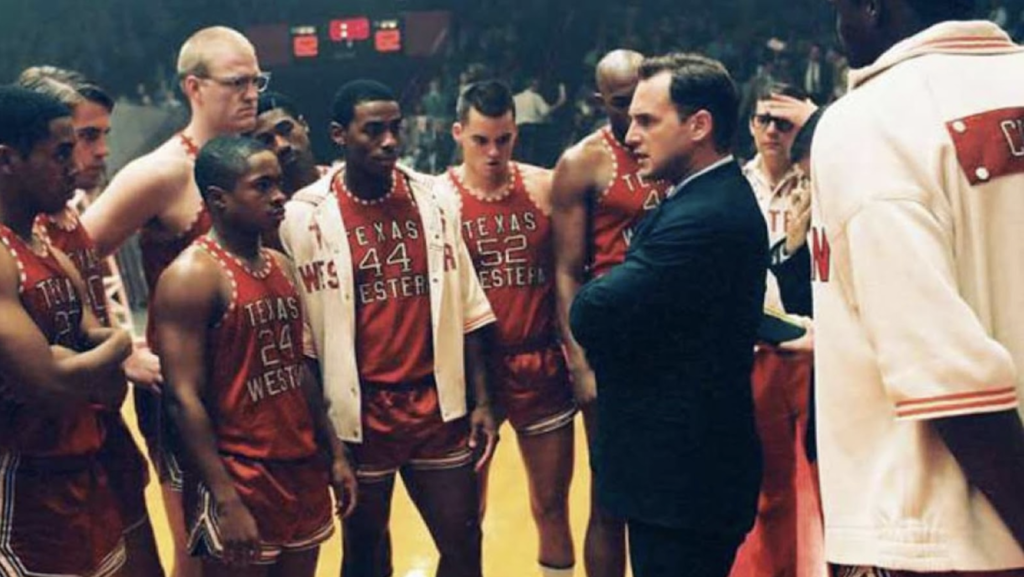
If you’re from Baltimore, chances are you’ve heard of Skizz Cyzyk and Joe Tropea (the latter being a copy editor for the Baltimore City Paper, and the former being a prolific shorts filmmaker, the founder of MicroCineFest and a major part, over the last ten years, of such varied film festivals as the Slamdance Film Festival, Maryland Film Festival, Atlanta Film Festival, Sidewalk Moving Picture Festival and the IndieMemphis Film Festival). This week’s focus on films currently in the trenches of film production zooms in on Skizz and Joe’s “Hit and Stay,” a documentary already three years in the making.
How did you two meet? What made you decide to work together on “Hit and Stay”?
SKIZZ: We met in 1993. Joe’s band was about to go on tour, but their drummer quit. I had a crush on the gal who co-ran their record label, so to impress her, I immediately jumped in to play drums on that tour. She and I have been together ever since, while Joe and I have gone on to play together in many bands, and work together on many film projects.
JOE: I started with the idea for the film in grad school. Skizz was the best available camera person I knew and he kept having time to help me shoot interviews. I decided he should be my co-director way before I asked him to do it-I knew he was really busy with a few other film projects and thought he’d just politely say no. Which is pretty much exactly what happened when I asked him the first time. But then he kept being available to shoot interviews with me and I kinda waited until he had so much time and effort into the project, I knew he wouldn’t say no. I liken it to Chinese water torture, eventually he was going to give in.
What is “Hit and Stay” about? How does the term “hit and stay” apply?SKIZZ: “Hit and Stay” is about the anti-war movement. In particular, the doc is about activists like the legendary Catonsville Nine, who were nine priests, nuns, and laypeople that broke into a draft board in 1968, stole draft records, burned the records in the parking lot, and then waited to be arrested. Their action inspired many similar actions, elevating the anti-war movement to something more serious than just college kids protesting.
JOE: The term “hit and stay action” is an anachronism. They didn’t used to call it that when they were breaking into draft boards or Dow Chemical back then. They called them “serious actions” or “stand-by actions,” where you act and then stand by or wait to be arrested. I didn’t like the sound of Stand-by as a title, and Serious Action sounds like something from another more risque genre. Also, I think Hit and Stay sums up the activists our film is about. They started taking moral stands on their convictions (civil rights, peace, etc.) and many of them are still doing their activism today.
Why tell this story now, some 35-40 years after the fact?JOE: There have been a few great films and shorts about this subject (“Investigation of a Flame,” “Camden 28,” “Weather Underground”) but none of them have given full treatment to the story we want to tell here. This started as a local story and then it went national. The very first action in Baltimore ended up inspiring many other similar actions across the country-and they weren’t just copycat actions. People started to improvise and put their own twist on the theme, and in many cases they totally outwitted the Feds. Then, of course, the Feds eventually infiltrated the “group” and things fell to s**t. It’s a fascinating story that not only connects to the current situation in Iraq and Afghanistan, it can also still be told by the people who lived it.
What do you hope the audience takes away from this film, when it’s finished?
JOE: Personally, I hope audiences react the way I reacted when I first started to meet the subjects of the film. I had to ask myself, Why aren’t I doing more? For peace. And to question the government and the wars we wage under what seem to me very perverse pretexts. I hope it makes people think about things as we currently have them set up.
Why did you decide to use crowdfunding for this project?
SKIZZ: We’ve watched several friends have good luck with crowdfunding. And really, it’s easier to send a link to a thousand people, and get a few hundred of them to donate enough small amounts, than it is to arrange a bunch of meetings with money people and hope any of them will give us anything.
How did you come to select $20,000 as the goal for this project? What does this amount of money pay for?
SKIZZ: It doesn’t cover everything we need, but it should get us over the next hump of production and post-production. We need to shoot some interviews in cities that are more than driving distance away from us. Color correction and sound mix are big costs, as are securing rights to photographs and news footage. Plus, to get this project edited, we’re going to need to fully focus on it, and that means we’ll need a little something to pay the bills while we’re not otherwise employed.
JOE: And again, it seemed like both a reach and a reasonable amount to ask for. We’ve seen our friends, like Matt Porterfield who made “Putty Hill,” have success with that amount, and at his urging we took a play out of his playbook. I made the mistake of reading some documentary filmmaker message boards and heard advice like, “Don’t be afraid to pay yourself $50,000 in planning your budget.” Well, that would be nice, but I really want people to see this film and to finish it.
 Why go with Kickstarter over IndieGoGo or other crowdsourcing options?
Why go with Kickstarter over IndieGoGo or other crowdsourcing options?
SKIZZ: Out of all of them, we were most familiar with Kickstarter when we made that decision. Had we known that some of them don’t require the “all-or-nothing” rule, we might have gone with one of the others.
JOE: Definitely, I second that. I’m not sure I understand Kickstarter’s rigid stance on “all-or-nothing.” It has a reality TV aspect that I’m not thrilled with. That said, it put us before more eyes than we otherwise would’ve had access to.
Since you’ve been working on this film since 2007, what horror stories have you and your production faced so far? Why has it taken so long?
SKIZZ: Well, for one, I quit my job in order to have time to work on this film, but then an opportunity came along to get a paycheck for making another film, so that project has sucked up most of my time for the past year. I like to think that the best documentaries take years to make anyway.
JOE: I have to say this has been a pretty smooth process. When we’ve traveled to shoot interviews, things have gone well. No bed bugs, yet. One unpleasantness is that a few people have passed away since we spoke to them. I’m not sure I should name names here. But I feel bad that we haven’t finished sooner so that they could’ve had the chance to see the film and tell us either we blew it or got it right.
If you do not hit your financial crowdfunding goal, what then?
SKIZZ: We’ll still finish this film one way or another. It just might take a little longer than we’d like.
What advice would you give to other filmmakers thinking of crowdfunding a documentary?
SKIZZ: Be fully prepared before launching your campaign. If you’re going to form an LLC, or have some way to accept tax deductible donations, get all of that worked out first.
JOE: Talk to as many other people who’ve been through it as you can. Think carefully about the duration of your campaign. How long can you live with yourself, the broken record asking for handouts? There really should be a support group for this.
If you’d like to know more about “Hit and Stay,” or we didn’t ask all the questions you’ve got, go ahead and comment below or head over to the “Hit and Stay” Kickstarter page and comment there. Next week we’ll be back with a new project for you to check out but, until then, we hope you enjoyed this closer look at Skizz Cyzyk and Joe Tropea’s “Hit and Stay.”
DISCLAIMER: Donating or investing in a film is always a risky endeavor, so it is important to keep that in mind before deciding to get financially involved with any film project. Film Threat, FilmThreat.com and our parent company, Hamster Stampede, LLC hold no liability or responsibility regarding any of the projects showcased on our site, their content or performance or the content or performance of any of the sites linked to in this article. Our involvement with the featured project is strictly what you see here: we find a work-in-progress project that sounds interesting to us, we ask all the questions we’d like to know the answers to and then we share that information with you, the audience. This should not be considered as personalized investment advice. What happens after you read this is your decision, and, again, before parting with any money for any film, think it through and BE CAREFUL.





am i the only one interested in this stuff? it’s going to look self serving (for me a member of the baltimore 4 to comment?)
so much great stuff going on now (5/2012) you almost don’t want to look back- i attended a wonderful Party for Socialism and Liberation conference the other day- look at their 10 point platform-look at the platform of Lutte Ouvriere in France
it’s not as if we didn’t have a blueprint- as to where to go
i think “Hit and Stay” still needs money- please donate
we have occupy, we have anti drone activity, we have Plowshares activity, we have Catholic Worker activity
for me, the greatest drawback of the mov’t today is the failure to name capitalism as the system causing all the wrack and ruin- that and the natural tendancy of humans to sit around jawing rather than acting
Why does Mr. Tropea have to wear a hoodee? he looks like a “hood rat”- and Mr. Skyzz looks like a guy from Tel Aviv or Brokelyn-
take advice indymen- go retro- it’s all the rage
Elder Dave latter day church of the lsd